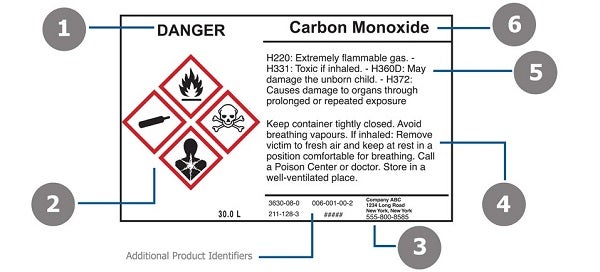Container Labeling
Unambiguous identification of hazardous materials in the workplace is of utmost importance . The overriding goal of prudent practice in the identification of hazardous materials is to avoid abandoned containers of unknown materials that may be expensive or dangerous to dispose of. The contents of all containers and transfer vessels, including, but not limited to, incoming commercial containers from the manufacturer, beakers, flasks, reaction vessels, and process equipment, should be properly identified.
Original Commercial Containers – Primary Containers
OSHA has adopted new hazardous chemical labeling requirements as a part of its recent revision of the Hazard Communication Standard (HCS), 29 CFR 1910.1200 Subpart Z , bringing it into alignment with the United Nations’ Globally Harmonized System of Classification and Labeling of Chemicals ( GHS Handbook_Revision 7 (The Purple Book) ).
The revised standard requires that information about chemical hazards be conveyed on labels using quick visual notations to alert the user, providing immediate recognition of the hazards. Labels must also provide instructions on how to handle the chemical so that chemical users are informed about how to protect themselves.
Note: While labels provide important information for anyone who handles, uses, stores, and transports hazardous chemicals, they are limited by design in the amount of information they can provide. Safety Data Sheets (SDSs), which must accompany hazardous chemicals, are the more complete resource for details regarding hazardous chemicals.
Labels of incoming manufactured products or chemicals must contain 6 key elements:

- Signal Word
- Pictograms
- Manufacturer Information
- Precautionary Statement(s)
- Hazard Statement(s)
- Product name or identifiers
OSHA requires that labels on incoming containers of hazardous materials must not be removed or defaced until the container is empty and rinsed. No product or chemical shall be accepted without an adequate identifying label. Original containers should be labeled with the date received and the date opened. This is particularly important for peroxide-forming compounds and other chemicals that become unstable over time, and it is good laboratory practice for ALL chemicals.
Replacement Container Label
The existing label on a container entering the workplace from a supplier must not be removed, altered or defaced. If a chemical container’s original label must be replaced, the new label must contain the same information as the original. Only use labels, ink and markings that are not soluble in the liquid content of the container.
Workplace Containers – Secondary Containers and Prepared Solutions
If chemicals are removed from their original container and placed in a different container, this container is referred to as secondary container. The secondary container may hold the original chemical, a mixture of chemicals, or a dilution of a chemical in water or solvent. Secondary containers must be labeled with:
- Full name(s) of the chemical(s), in English. Do not use abbreviations as these can be ambiguous, no drawings or formulas;
- Hazard identification such as flammable, toxic, corrosive;
- Date of transfer or preparation;
- Name of person who transferred or prepared the solution;
- If the container holds a solution or mixture, concentrations and solvents used (e.g., 1M hydrochloric acid; 40% acetonitrile / 60% water; 1 mg/ml naphthalene in hexane).
Make sure the label remains legible. Use a permanent marker that does not dissolve in water or the solvent used, or attach an adhesive label with the required information. For long term storage, check the label periodically and replace it if it has become illegible.
Very small containers such as vials can be labeled with a number or other code as long as they are accompanied by an explanation sheet, readily available, that lists the required information. If contents of vials are identical, the rack or secondary containment holding the vials can be labeled with the above listed requirements.
“Immediate Use” Containers
Containers into which chemicals are filled only for the duration of the experiment, such as beakers, flasks, or test tubes, are referred to as immediate use containers. At a minimum, they should be labeled with the name of the chemical. Common abbreviations whose meaning is clear to EVERYBODY in the lab are acceptable. A key should be posted in the work area or in lab notebook.
Containers holding non-hazardous substances such as water must also be labeled to avoid confusion with other clear and colorless chemicals. It is acceptable to label these containers “Non-Hazardous”.
Safety label templates are available to you (will be linked). It is not required that you use these specific labels.